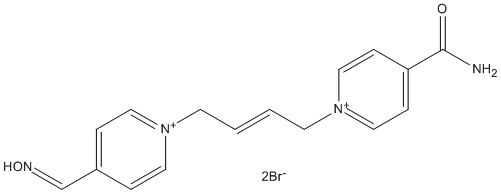K203
General
Type : Oxime, Bispyridinium
Chemical_Nomenclature : [1-[(E)-4-(4-carbamoylpyridin-1-ium-1-yl)but-2-enyl]pyridin-4-ylidene]methyl-oxoazanium
Canonical SMILES : C1=CN(C=CC1=C[NH+]=O)CC=CC[N+]2=CC=C(C=C2)C(=O)N
InChI : InChI=1S\/C16H16N4O2\/c17-16(21)15-5-11-20(12-6-15)8-2-1-7-19-9-3-14(4-10-19)13-18-22\/h1-6,9-13H,7-8H2,(H-,17,21)\/p+2\/b2-1+
InChIKey : UILZOFLNCNKRGW-OWOJBTEDSA-P
Other name(s) : (E)-1-(4-carbamoylpyridinium)-4-(4-hydroxyiminomethyl-pyridinium)-but-2-ene dibromide, K-203, CHEMBL1182443, STL301833, ZINC28861846, AKOS022133526, 4-carbamoyl-1-[(2E)-4-{4-[(E)-(hydroxyimino)methyl]pyridinium-1-yl}but-2-en-1-yl]pyridinium, AKOS016372534, HY-146959, CS-0459568
MW : 298.33
Formula : C16H18N4O2
CAS_number :
CID PubChem :
InChIKey UniChem :
Iuphar :
Wikipedia :

Target
Structure : No structure
Families : No family
References
No reference